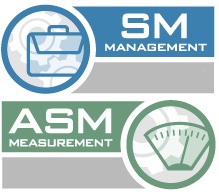SM/ASM 2001 - Software Management & Applications of Software Measurement

PRESENTATIONS
|
Software Improvement Feedback Loops: How to Develop a Learning Organization
Over the past twenty-five years, the Software Engineering Laboratory (SEL) at NASA/GSFC has studied mechanisms for improving the software process and product. During this time, a set of processes has evolved: the Goal/Question/Metric Paradigm; the Quality Improvement Paradigm; and the Experience Factory Organization. These processes are based on the needs for measurement and feedback loops, from project to process and project to project, creating a learning organization for building software competencies. |
|
|
Software Metrics "State of the Practice"
In this session, Peter Kulik presents the results of KLCI's third industry survey on software metrics usage conducted in the fourth quarter of 2000. Based on feedback from practitioners, you will explore topics such as metrics usage and best practices, tips to enhance metrics programs, strategies to implement and improve a metrics program, and tools favored to support metrics capture and analysis. |
|
|
Software Requirements: When They Think They Know What I Want… and They Don't
Pat Medvick presents tales of successful and unsuccessful attempts at gathering requirements from scientists-highlighting the inherent problems and possible solutions. Learn how to gather requirements from multi-site domain experts. Discover ways to develop a flexible software design that permits requirements gathering throughout software development. |
|
|
Statistical Process Control (SPC) for Software Inspections
Attempts to create user-friendly statistical process control (SPC) charts for software inspections often have |
|
|
Success Factors and Measures in Outsourced Application Development
Today's e-conomy is creating higher time pressures than ever in application development. Many organizations are responding to the deadline pressures and backlogs through partnering. Whenever new partnering relationships are created, however, conflict can result. Learn the four key critical success factors to help you manage this type of strategic relationship, including how to deal with "shotgun weddings" and creating better dispute resolution frameworks. |

Michael Mah, QSM Associates, Inc. |
|
Successful Project Management in the Face of Shifting People and Teams
The best project managers know to superbly manage the subtleties of risks, employee turnover, personality clashes, shifting priorities, and other unexpected events. And they know how to motivate even mediocre employees to produce exceptional results. The biggest challenge is facing the fact that no project proceeds predictably and according to plan. Learn practical day-to-day techniques you can use to achieve extraordinary project success in spite of seemingly insurmountable setbacks. |
|
|
Successful Projects-10 Keys to a Proper Beginning
One of the primary keys to project success is orchestrating a proper beginning. In order to do this effectively, you must define the project mission, vision, and reason for being; get a handle on requirements; take the time to load the team properly; do the prerequisite work in gaining focus and clarity; and decide on the development methods and strategies. In this presentation, learn the five keys to forming your team and the five keys to successfully starting a project. |
|
|
System Architectures-An International Viewpoint
The software engineering industry has invented a wide variety of architectures and technologies for building applications, yet all of these architectures have some common features and issues. One such common issue is internationalization. No matter how you build your application, it will more than likely be viewed and used by people from different cultures, nationalities, and backgrounds. This presentation gives you a lighthearted tour of the common application architectures. |
|
|
System Test Measurement-What, When, How?
Elaine Soat presents an easy set of measurements to use during system testing (QA test cycle). Examine measurements taken from defect tracking and application coverage to projected testing hours versus actual testig hours. Learn how such process and measurement information is evaluated and used for proposed process improvements. Gain the ability to do comparison reporting to measure successes of process improvement within your QA test cycle. |
|
|
The Impact of Team/Personal Software Processes
Several years ago, the Naval Oceanographic Office initiated its process improvement effort with Team Software Process (TSP) and Personal Software Process (PSP) as its foundation. Learn about the areas in which TSP/PSP made a significant impact on implementing change relating to the organization's CMM maturity level. |
|


